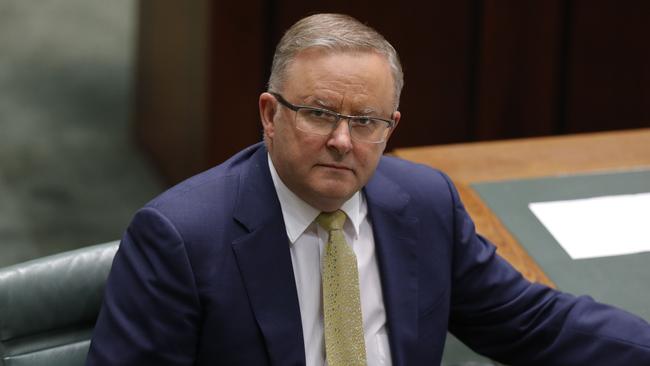Labor misfires on policy with not much left to lose


To the extent that anyone can remember what Labor stood for at the last election, the lasting impressions are of higher taxes (think negative gearing, capital gains tax, franking credits) and an extraordinarily ambitious but uncosted emissions reduction target.
We don’t hear much about Labor’s plan to increase taxes these days. We can assume that the complex array of tax changes proposed by their former Treasury spokesman, Chris Bowen, are as dead as a doornail. Why would Labor bother, seeing that there are now seemingly no constraints on the federal government running up deficits?
Albanese has already ditched the 45 per cent by 2030 emissions reduction target, opting instead for the vague and faraway dream of net zero emissions by 2050. Certainly, there is a bun fight going on within his party about climate policy, and the role of gas in particular. He is just hoping he can paper over the cracks going into the election. But it’s hard to fill up a budget-in-reply speech with just flowery rhetoric and slightly snide remarks about government policy. So Albanese opted to throw in two stupid policy proposals in the hope that some voters might feel favourably disposed to the Labor cause. These were extending even further subsidies to centre-based childcare and creating a new government body to subsidise the building of electricity transmission to assist the renewable energy sector. Both ideas are costly and won’t achieve the objectives they are expected to meet.
Take the childcare proposal. Labor wants to increase the subsidy rate for low-income earners to 90 per cent and remove the annual cap on childcare subsidies. What this latter measure does is extend the availability of subsidies to families with incomes greater than $354,000 per year, the current level of income at which subsidies cut out.
You may well ask how many families actually earn more than $354,000. In 2017-18, fewer than 4 per cent of households had gross incomes over $312,000 per year. (Median household income was only $88,000.) Assuming some growth in household income since then, we can surmise that around 3 per cent of households earn incomes of $354,000 or more.
What Labor is proposing to do is spend an additional $6.2bn over three years to further subsidise childcare costs, including those of these very-high-income households. In many cases, this money will be expended without altering labour market behaviour.
Economists call these deadweight costs, and Labor’s idea will induce more of these costs in spades. It also doesn’t fully fix the disincentive for some mothers to work more than two to three days per week. Of course, the childcare centre owners will rejoice, given that they are the main beneficiaries of subsidy arrangements. It will also continue the system’s core deficiency of subsidies driving higher fees which, in turn, lead to higher government spending. Indeed, the most recent figures point to fee increases well above the rate of price and wage inflation.
What is actually required is a fundamental rethink of the means of assisting parents with the cost of childcare and the interaction with the tax-transfer system. Options other than providing subsidies for centre-based care should be considered. One possibility is capped tax-deductibility of childcare costs. As for those activists who think that childcare should be made free-of-charge for everyone, they fall into the rookie trap of using GDP as the measure of community wellbeing. Let’s not forget a mother staying at home to care for children isn’t counted in GDP but is still a worthwhile activity.
The notion that universal childcare subsidies would somehow pay for themselves is, of course, fanciful. Indeed, there is a possibility that the impact on participation could be perverse, as any labour market activity test would be close to impossible to enforce.
In any case, the big jump in female labour force participation in Australia significantly predates the subsidisation of childcare costs. Moreover, average productivity may actually decline with “free” childcare as more marginal workers enter the workforce — a point made by the Productivity Commission.
When Albanese states that “this is real reform — it will boost women’s workforce participation, boost productivity and get Australia working again, delivering a much-needed boost in economic growth of up to $4bn a year”, this is just economic piffle. Note also that $4bn is trivial, given that annual GDP is close to $2 trillion.
Labor’s second big idea is to commit $40bn to subsidise the building of new transmission lines to assist the renewable energy sector. To be called the Rewiring the Nation Corporation, the idea is that the transmission companies, some of which are owned by foreign sovereign wealth funds, will be able to access the commonwealth’s ability to borrow funds at very low interest rates. Mind you, these companies are already able to access debt at very low rates.
There is a lot of confused thinking in this proposal. The two main current impediments to the construction of new transmission lines are, first, the need for regulatory approval, and, second, the sheer costs. The transmission companies won’t commit to new projects without regulatory approval because of their desire for the guaranteed rate of return on capital that approval provides.
It’s not clear how the establishment of a new government corporation will alter this barrier. And when asked whether the lower cost of capital these transmission companies would face would lead to lower guaranteed rates of return — and hence lower consumer prices — Labor’s response has been in the negative.
As for the cost of these projects, there is clear evidence that blowouts are occurring. The proposed South Australia-NSW interconnector, for example, is now expected to cost more than 50 per cent more than the original estimate. Labor’s loopy idea that only Australian materials would be used for their construction is a combination of impossible and costly. The real question is why Labor thinks it should provide subsidies to transmission companies. Who will be the real winners?
Being in opposition is difficult at the best of times. But to focus on providing more childcare subsidies, including for very high-income households, and handouts to highly profitable transmission companies, is to call into question what Labor really stands for these days.



Let’s face it, it’s not easy being in opposition these days. Having lost the close-to-unlosable election last year and with Bill Shorten gone, Labor under Anthony Albanese has struggled to gain any traction with the electorate.